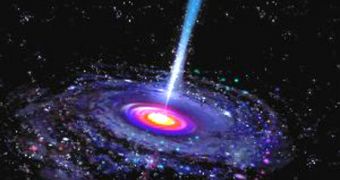According to the results of an interesting new analysis, it would appear that black hole may exist in a type of space-time-defined space that is independent of time itself. This type of environment, in which time is essentially frozen still, is called the Kerr spacetime.
The same study shows that this is the end state towards which a black hole strives to evolve. Therefore, experts even propose a new method of determining how much structures of this type have to go before they get to live their lives in such a peculiar spacetime.
One of the things that make these dark behemoths so hard to investigate is the fact that there is no way of collecting accurate, reliable readings about their structure or make up. They are believed to be points in space where the highest mass is packed into the tiniest volume.
In all respects, this is where all materials come to meet their end, being squashed to their ultimate density. Over the past few years, technological and scientific advancements have allowed us to infer the existence of more and more black holes around the Universe.
They can be found literally everywhere, experts say, but they cannot be analyzed for a very practical reason – the theory of general relativity breaks down when it comes to explaining black holes.
This set of equations was developed by famed physicist Albert Einstein, with the purpose of explaining the role of spacetime and gravity in shaping the Universe we see today. The theory works great for explaining everything except phenomena that go on in and around black holes.
“It is really beyond the physics we know. To understand what happens inside a black hole, we need to invent new physics,” explains Queen Mary, University of London mathematician Juan Antonio Valiente Kroon, quoted by Space.
He explains that one of the solutions that general relativity produces for the end of a black hole's evolution is called the Kerr spacetime. “Mainly the equations of relativity are so complex that for relativistic systems, the only way you can probe these equations is by means of computer,” Valiente Kroon explains.
“Solutions like this Kerr solution are really exceptional. The Kerr solution is one of the few explicitly known solutions to general relativity that have a direct physical meaning,” he goes on to say, adding that this type of spacetime is completely time-independent.
This means that absolutely nothing included in this frame of reference changes over time. Another way of interpreting this is saying that time stands completely still. This means that black holes which reached the end of their evolutionary cycle are essentially stationary.
“One could say once it has reached this stage, there are no further processes taking place,” Valiente Kroon explains. Details of his theoretical work appear in the January 19 issue of the esteemed journal Proceedings of the Royal Society A.

 14 DAY TRIAL //
14 DAY TRIAL //